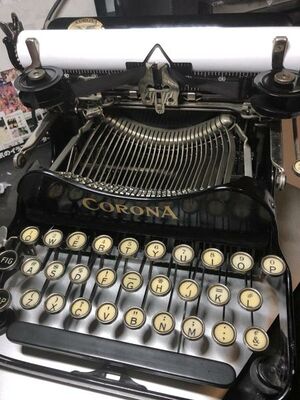Difference between revisions of "Smith-Corona"
| Line 7: | Line 7: | ||
_As Corona_ | _As Corona_ | ||
| − | In 1909, the Standard Folding company was acquired by an investor and moved to Groton, N.Y. In 1912, after a variety of edits had been made to the basic Standard Folding design, it was redesigned and marketed as the Corona 3. This new machine saw great success. | + | In 1909, the Standard Folding company was acquired by an investor and moved to Groton, N.Y. In 1912, after a variety of edits had been made to the basic Standard Folding design, it was redesigned and marketed as the Corona 3. This new machine saw great success. A variant, the "3 Special", was introduced in the early 1920s; it featured right-hand shift keys and came in colors like red, blue, and green, or gold inlays on black. |
[[File:Corona3.jpg|400x400px|thumb]] | [[File:Corona3.jpg|400x400px|thumb]] | ||
| − | Eventually, the folding 3-bank Corona | + | Eventually, the folding 3-bank Coronas were superseded by the Corona 4, a slightly larger machine retaining the distinctive curves of the 3, but adopting a 4-bank standard keyboard. The 3 remained in production until 1941, however, outlasting the 4. |
| + | |||
| + | _L.C. Smith and Bros._ | ||
| + | |||
| + | As the Corona typewriter company was rapidly growing, L.C. Smith and Brothers had been making standard office typewriters. Due to legal issues, the former inventors of the [[Smith Premier]] had started a new company, and created a new standard that used ball-bearings in the type arms, rather than a conventional segment. Based out of Syracuse, N.Y., the L.C. Smith was a very popular standard and continued to be produced after the L.C. Smith and Corona merger. | ||
| + | |||
| + | _As Smith-Corona_ | ||
| + | |||
| + | In 1925, L.C. Smith and Bros. merged with the Corona Typewriter Co. to create Smith-Corona, formally L. C. Smith and Corona Typewriters Inc. | ||
Revision as of 20:09, 22 May 2021
Smith-Corona, also known as Standard Folding, Corona Typewriter Co., L. C. Smith and Brothers, L. C. Smith and Corona, and Smith-Corona Marchant, was and is one of the most illustrious typewriter companies to exist.
_As Standard Folding_
In 1906, the Standard Folding Type-Bar Typewriter CO. is established. Engineer Frank Rose created a folding machine that would fold in half, making it a truly portable machine to compete with the one other lightweight model on the market: the Blickensderfer. Having typebars and a more conventional layout, the design had potential. Some 12 000 Standard Foldings were made, and they are a rather rare and desirable machine today. Eventually, the Standard Folding would be rebranded into one of the most popular machines to ever have existed, the Corona 3.
_As Corona_
In 1909, the Standard Folding company was acquired by an investor and moved to Groton, N.Y. In 1912, after a variety of edits had been made to the basic Standard Folding design, it was redesigned and marketed as the Corona 3. This new machine saw great success. A variant, the "3 Special", was introduced in the early 1920s; it featured right-hand shift keys and came in colors like red, blue, and green, or gold inlays on black.
Eventually, the folding 3-bank Coronas were superseded by the Corona 4, a slightly larger machine retaining the distinctive curves of the 3, but adopting a 4-bank standard keyboard. The 3 remained in production until 1941, however, outlasting the 4.
_L.C. Smith and Bros._
As the Corona typewriter company was rapidly growing, L.C. Smith and Brothers had been making standard office typewriters. Due to legal issues, the former inventors of the Smith Premier had started a new company, and created a new standard that used ball-bearings in the type arms, rather than a conventional segment. Based out of Syracuse, N.Y., the L.C. Smith was a very popular standard and continued to be produced after the L.C. Smith and Corona merger.
_As Smith-Corona_
In 1925, L.C. Smith and Bros. merged with the Corona Typewriter Co. to create Smith-Corona, formally L. C. Smith and Corona Typewriters Inc.
